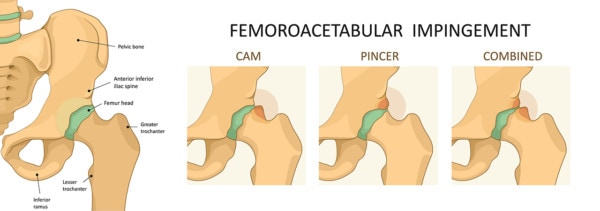Hip Impingement Exercises: Can You Fix It with Therapy and Avoid Surgery?
Can hip impingement exercises help avoid surgery? The diagnosis of hip impingement that leads to surgery has been all the rage lately, despite research showing that in some cases, what’s diagnosed as “impingement” may actually be protecting rather than harming the joint. What we don’t know is how simple changes in posture can impact FAI (femoroacetabular impingement). Now a new study sheds some light on the issue.

Logika600/Shutterstock
FAI or hip impingement sounds like what it is-the hip joint gets pinched or impinged by bone. There are two main types-pincer and CAM. This past 5 years, there’s been an explosion in hip surgery for a diagnosis that barely existed 10 years ago. The theory behind the surgery is that in many patients, reshaping the hip joint will end up reducing that impingement and saving the joint from arthritis. There are just a few problems with that concept. The first is that a recent well done study showed that pincer hip impingement wasn’t really impingement at all, but a bone spur that forms to protect the joint. Hence removing this protective bone spur isn’t a great idea. In addition, we don’t have high levels of scientific evidence that hip impingement surgery works. In fact, if it goes the way of meniscus surgery, where better studies show no efficacy, then more research may not show that operating on all of these hips was a good idea.
Could something as simple as posture play a role in hip impingement? After all, the old adage that the knee bone’s connected to the hip bone is often ignored by our modern surgery based orthopedics system. The new research looked at almost 50 young patients who had undergone surgery for FAI with 3D CT scans of their pelvis. The researchers then altered the patient’s posture and then remeasured all of the angles and other measures hip surgeons use to decide who is or is not a candidate for FAI surgery. Tilting the pelvis forward resulted in more hip impingement, while tilting it backwards resulted in less.
The upshot? The fact that you can impact hip impingement by just changing the tilt of your pelvis is concerning. Why are we operating on all of these hips when the actual impingement in some may be as simple as changes in posture with age or various types of low back pain? Are we really solving anything or just putting an invasive band-aid on the real problem? What can you do if you’ve been diagnosed with FAI? Work with an experienced physical therapist or program like Egoscue that can correct the simple bio mechanical problems that could be the true cause of your hip problem!
If you have questions or comments about this blog post, please email us at [email protected]
NOTE: This blog post provides general information to help the reader better understand regenerative medicine, musculoskeletal health, and related subjects. All content provided in this blog, website, or any linked materials, including text, graphics, images, patient profiles, outcomes, and information, are not intended and should not be considered or used as a substitute for medical advice, diagnosis, or treatment. Please always consult with a professional and certified healthcare provider to discuss if a treatment is right for you.